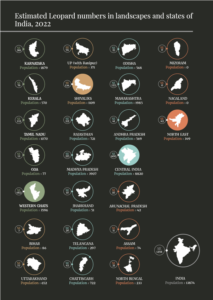CSIP: PRELIMS BOOSTER SERIES – 556 ENVIRONMENT
LEOPARD
Why in News?
Union Minister for Environment, Forest and Climate Change, Shri Bhupender Yadav released the report on Status of Leopards in India, at New Delhi. The fifth cycle leopard population estimation was carried out by the National Tiger Conservation Authority and Wildlife Institute of India, in collaboration with State Forest Departments, as part of the quadrennial “Monitoring of Tiger, Co-predators, prey and their habitat” exercise in tiger range States. This exercise has proved invaluable to the conservation efforts of the country.
What are the Findings?
- India’s leopard population is estimated at 13,874 (Range: 12,616 – 15,132) individuals, representing stable population in comparison to the similar area being sampled in 2018 with 12852 (12,172-13,535) individuals. This estimate represent population of 70% of leopard habitat, the Himalayas and semi-arid parts of country which are not tiger habitat were not sampled.
- Central India shows a stable or slightly growing population of leopards (2018: 8071, 2022: 8820), Shivalik hills and Gangetic plains experienced decline (2018: 1253, 2022: 1109). If we look at the area which was sampled both in 2018 and 2022 across India, there is a 1.08% per annum growth. In Shivalik hills and Gangetic plains, there is a -3.4% decline per annum, while the largest growth rate was in Central India and Eastern Ghats of 1.5%.
- Madhya Pradesh houses the largest population of leopards in the country – 3907 (2018: 3421), followed by Maharashtra (2022: 1985; 2018: 1,690), Karnataka (2022: 1,879; 2018: 1,783) and Tamil Nadu (2022: 1,070; 2018: 868). Tiger Reserves or sites with highest leopard population are, Nagarajunasagar Srisailam (Andhra Pradesh), followed by Panna (Madhya Pradesh), and Satpura (Madhya Pradesh).


